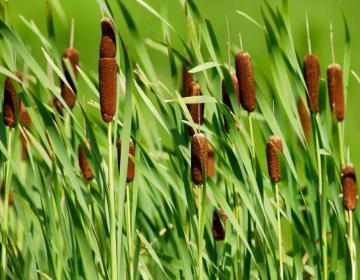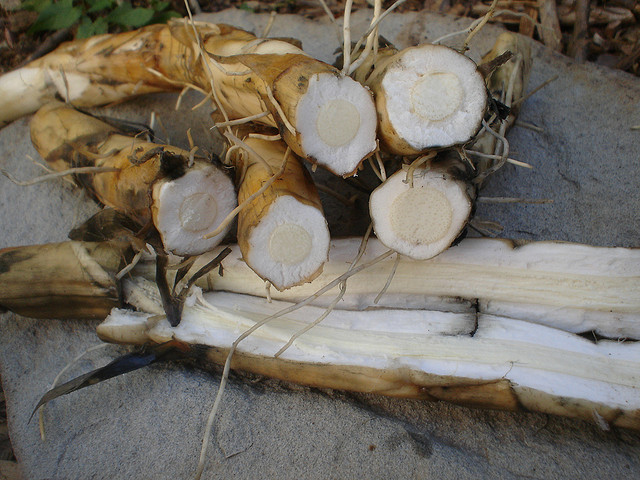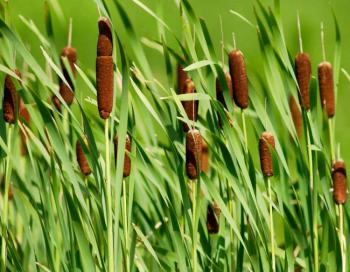
Common name(s): cattails, bulrush, reedmace [1]
Scientific Name(s): Typha latifolia
Island Hullkemel’em Name(s): sth’a:qel
Family: Typhaceae
Caution(s): Cattails readily take up pollutants into their tissues. Do not harvest edible parts from polluted watersheds.
Botanical Description: Cattails (T. latifolia) are an aquatic herbaceous perennial routinely found in wetlands, marshes, ditches and shorelines. Cattails are distinguishable by the brown hotdog-like seed head on each stalk. This is the female flower and the male flower forms a narrow spike on top of the seed head. When ripe, the heads disintegrate into fluff and disperse primarily by the wind. Cattails have a large underwater rhizomes (“roots”) that allow for rapid and dense proliferation. The plants stand erect at 1.5 to 3 meters tall. Their leaves are narrow and linear, with 12-16 arising from each vegetative shoot. [2]
Current Distribution and Local Habitat(s): Cattails are found all over the world including North America, Asia, Europe and Africa. It can typically be found growing in dense stands with shallow water or seasonal flooding. Cattails thrive in extremely moist environments such as wetlands, freshwater marshes, ditches, ponds and shorelines. These plants can become invasive, but have the important ecosystem service of filtering run-off in watersheds. [3]
Ethnobotanical Application(s): Cattail leaves are a very important weaving material for Interior and Cost Salish First Nations. They can be woven into mats, bags, baskets and shelters. Pollen and roots can be pounded into a starchy flour for eating and thickening. The roots contain more starch than potatoes and more protein than rice! Young cattail shoots can be eaten in the early spring. The top of the flower head can be harvested and cooked, apparently tasting like corn. Cattails also have a variety of medicinal purposes. The pollen is used to stop bleeding, while a poultice of the root can be used to treat infected wounds and burns. Fluff from the seed heads can be used as insulation, padding, bedding and fire starter. [3, 4]


Figure 1. Cattails roots (left) and cattail seed fluff (right)
View a presentation of how to make a cattails bag and pillow here
Uvic Campus Location(s): Cattails can be found in the First People’s House pond, Mystic Vale, the David Turpin Building courtyard, along Mackenzie Avenue and at the University Club pond.
Written by: Elise Pullar
Figure Reference(s):
[1] https://nature.mdc.mo.gov/sites/default/files/styles/centered_full/publi...
[2] http://www.ediblewildfood.com/cattail.aspx
[3] http://www.ecy.wa.gov/programs/wq/plants/native/cattail.html
[4] www.nativetech.org/plantgath/cattail.htm
Project Status:
Year:
Associated Projects:
Image:

